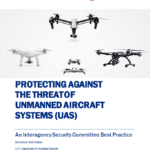
This document provides guidance for federal Executive Branch departments and agencies regarding best practices, lessons learned, and recommendations to protect against the threat of malicious unmanned aircraft systems (UAS) operations.
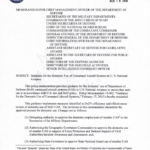
This policy memorandum provides guidance for the domestic1 use of Department of Defense (DoD) unmanned aircraft systems (UAS) in U.S. National Airspace to ensure that such use is in accordance with U.S. law and DoD policy. Policy Memorandum 15-002, “Guidance for the Domestic Use of Unmanned Aircraft Systems,” February 17, 2015 is hereby rescinded. This guidance implements measures identified in DoD’s efficiency and effectiveness review of domestic use of DoD UAS. The revisions in this memorandum streamline the approval process for domestic use.
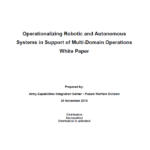
Robotic and Autonomous Systems (RAS) and artificial intelligence (AI) are fundamental to the future Joint Force realizing the full potential of Multi-Domain Operations (MDO 1.5). These systems, in particular AI, offer the ability to outmaneuver adversaries across domains, the electromagnetic (EM) spectrum, and the information environment. The employment of these systems during competition allows the Joint Force to understand the operational environment (OE) in real time, and thus better employ both manned and unmanned capabilities to defeat threat operations meant to destabilize a region, deter escalation of violence, and turn denied spaces into contested spaces. In the transition from competition to armed conflict, RAS and AI maneuver, fires, and intelligence, surveillance, and reconnaissance (ISR) capabilities provide the Joint Force with the ability to deny the enemy’s efforts to seize positions of advantage.
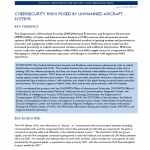
The Department of Homeland Security (DHS)/National Protection and Programs Directorate (NPPD)/Office of Cyber and Infrastructure Analysis (OCIA) assesses that unmanned aircraft systems (UASs) provide malicious actors an additional method of gaining undetected proximity to networks and equipment within critical infrastructure sectors. Malicious actors could use this increased proximity to exploit unsecured wireless systems and exfiltrate information. Malicious actors could also exploit vulnerabilities within UASs and UAS supply chains to compromise UASs belonging to critical infrastructure operators and disrupt or interfere with legitimate UAS operations.
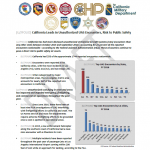
California has had more disclosed unauthorized Unmanned Aircraft Systems (UAS) encounters than any other state between October 2015 and September 2016—accounting for 21 percent of the reported encounters nationwide—according to the Federal Aviation Administration (FAA). These encounters continue to pose a direct risk to public safety air assets.
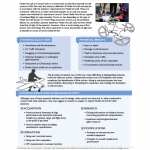
Model Aircraft are custom built or commercially produced unmanned aircraft systems (UAS) that meet the statutory definition of Model Aircraft and operate in accordance with the statutory requirements for Model Aircraft. These are sometimes referred to as radio controlled airplanes or aircraft and usually require one individual for operational control. Some Model Aircraft are capable of sustained flight for approximately 2 hours or less depending on the type of Model Aircraft (Rotary or Fixed Wing) and power source (e.g. nitromethane, lithium ion, and lithium polymer batteries). Model Aircraft must be flown within visual line of sight of the operator; however, there is an increasing use of first person view technology that allows operation to occur beyond line of sight and at altitudes in excess of several hundred feet.
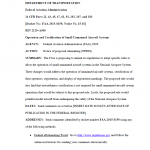
The FAA is proposing to amend its regulations to adopt specific rules to allow the operation of small unmanned aircraft systems in the National Airspace System. These changes would address the operation of unmanned aircraft systems, certification of their operators, registration, and display of registration markings. The proposed rule would also find that airworthiness certification is not required for small unmanned aircraft system operations that would be subject to this proposed rule. Lastly, the proposed rule would prohibit model aircraft from endangering the safety of the National Airspace System.
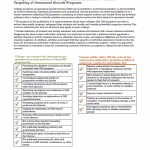
College programs in unmanned aircraft systems (UAS) are susceptible to potential penetration or attack plotting by violent extremists. Enhanced information and operational security practices can reduce the likelihood of a violent extremist infiltrating UAS programs or planning an attack against students and faculty. There are potential indicators that a student or faculty member may possess ulterior motives for their interest in unmanned aircraft.
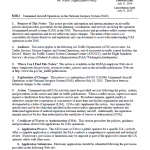
Purpose of This Notice. This notice provides information and interim guidance on air traffic policies and prescribes procedures for the planning, coordination, and services involving the operation of unmanned aircraft systems (UAS) in the NAS. These policies and procedures reflect current written directives and regulations and do not reflect any major changes. The intent of this notice is to consolidate all current directives and regulations into one document to assist with understanding UAS operations in the NAS.
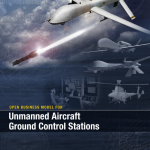
Over the past twenty years, the Department of Defense (DoD) has acquired a diverse portfolio of Unmanned Aircraft Systems (UAS) across the Military Services to meet its national security needs. Newly emergent threats and evolving national security requirements are prompting the DoD to re-evaluate its entire portfolio of systems, while at the same time, seeking to reduce the total ownership costs including lifecycle sustainment costs of these systems. The anticipated reduction in defense spending in concert with advances in information technology provides ample opportunity for DoD to rethink how it acquires, designs, and builds its systems. As a result, DoD is adopting and exploiting open system design principles and architectures to increase competition, foster reuse across systems, and increase interoperability. This new acquisition model requires access to multi-vendor solutions to enable rapid insertion of new technologies to counter emerging threats, avoid technology obsolescence, and decrease time to field new capabilities. DoD is adopting an Open Business Model (OBM) to support the implementation of an Open Architecture (OA) for UAS Ground Control Stations (GCS) in order to drive greater acquisition efficiencies and reduce the total ownership costs. This new model is built upon several lessons learned from the Navy’s own open architecture efforts in the submarine community when it radically changed its approach to building weapon systems due to an emerging threat from an adversary in conjunction with declining budget.
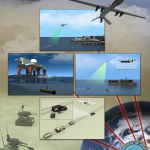
The purpose of this Roadmap is to articulate a vision and strategy for the continued development, production, test, training, operation, and sustainment of unmanned systems technology across DoD. This “Unmanned Systems Integrated Roadmap” establishes a technological vision for the next 25 years and outlines actions and technologies for DoD and industry to pursue to intelligently and affordably align with this vision.
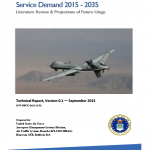
This report assesses opportunities, risks, and challenges attendant to future development and deployment of UAS within the National Airspace System (NAS) affecting UAS forecast growth from 2015 to 2035. Analysis of four key areas is performed: technology, mission needs, economics, and existing or anticipated challenges to routine use in NAS operations. Forecast effects of emerging technologies as well as anticipating new technological innovations in areas of airframes, powerplants, sensors, communication, command and control systems, and information technology and processing are evaluated. Anticipated mission needs include intelligence, surveillance and reconnaissance (ISR), as well as new areas such as stores delivery, cargo transport, search and rescue, and pilot augmentation; example business case models are developed for each of these areas. Challenges to routine UAS usage in the NAS include: absence of legislation and regulations for safe flight in integrated airspace; pilot training and certification; regulatory, policy, and procedural issues; social issues, such as privacy and nuisance concerns; environmental issues, such as noise and emissions; and safety.

A collection of presentations from June 2012 detailing the NASA Unmanned Aircraft Systems (UAS) Integration in the National Airspace System (NAS) Project’s efforts to integrate drones into the national airspace including technical problems with frequency allocation as well as technologies designed to avoid mid-air collisions.
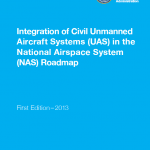
Since the early 1990s, unmanned aircraft systems (UAS) have operated on a limited basis in the National Airspace System (NAS). Until recently, UAS mainly supported public operations, such as military and border security operations. The list of potential uses is now rapidly expanding to encompass a broad range of other activities, including aerial photography, surveying land and crops, communications and broadcast, monitoring forest fires and environmental conditions, and protecting critical infrastructures. UAS provide new ways for commercial enterprises (civil operations) and public operators to enhance some of our nation’s aviation operations through increased operational efficiency and decreased costs, while maintaining the safety of the NAS.
It shall be the mission of those personnel of the Seattle Police Department who are trained in the use of unmanned aerial systems (UAS), to use this resource to protect the lives and property of citizens and first responders in a constitutionally and legally sound manner. Use of an aerial system can be utilized in circumstances which would save life and property, as well as being able to detect possible dangers that could not otherwise be seen.
The Chief of Naval Operations (CNO) Strategic Studies Group (SSG) is chartered with generating revolutionary naval warfighting concepts. SSG XXVIII has been tasked to generate innovative concepts for the operational and tactical employment of unmanned systems, in all domains, as an integral part of the Naval Force for 2020 and beyond. From these innovative concepts, SSG XXVIII is also tasked to produce recommendations and actionable steps for implementation of unmanned systems integration into the Navy’s force structure. This Way Ahead Plan provides a framework for SSG XXVIII’s approach to address this task and challenge. It includes a summary of the SSG’s preliminary thoughts on the value of unmanned systems, an initial overarching concept, and associated concept teams and areas of interest.
A presentation from April 2012 discussing NASA’s Unmanned Aircraft Systems (UAS) Integration in the National Airspace System (NAS) Project which will work to overcome problems integrating drones into the domestic airspace.
While reliance on UAS continues to grow, the ability to integrate UAS into the National Airspace System (NAS) to support operations, training, and testing has not kept pace. Routine access to exercise and execute Combatant Command (COCOM)-tasked missions, and to support broader military and civil missions such as Homeland Security (HLS), Homeland Defense (HD), and Defense Support of Civil Authorities (DSCA) is necessary. Current NAS access for UAS is greatly limited under interim FAA policies that govern UAS operations in the NAS. Currently, DoD UAS operations conducted outside of Restricted, Warning and Prohibited areas are authorized under a temporary Certificate of Waiver or Authorization (COA) from the Federal Aviation Administration (FAA) or under limited conditions outlined in the 2007 DoD-FAA Memorandum of Agreement (MoA). Although DoD has been able to facilitate a small number of flights through the COA process, DoD has not been able to obtain the level of airspace access necessary to accomplish the wide range of DoD UAS missions at current and projected operational tempos.
Several statistics reports on unmanned aircraft systems (UAS) mishaps that are compiled yearly by the Air Force Safety Center. The following reports are the most recent that are publicly available.
This is the first report of progress in producing a NextGen Unmanned Aircraft Systems Research, Development and Demonstration Roadmap (NextGen UAS RD&D Roadmap). The activity was established to enable a responsive, efficient, timely, coordinated multiagency Research and Development (R&D) effort that will enable the U.S. to realize fully the benefits of Unmanned Aircraft Systems (UAS) in the National Airspace System (NAS).
U.S. and allied combat operations continue to highlight the value of unmanned systems in the modern combat environment. Combatant Commanders (CCDRs) and warfighters value the inherent features of unmanned systems, especially their persistence, versatility, and reduced risk to human life. The U.S. military Services are fielding these systems in rapidly increasing numbers across all domains: air, ground, and maritime. Unmanned systems provide diverse capabilities to the joint commander to conduct operations across the range of military operations: environmental sensing and battlespace awareness; chemical, biological, radiological, and nuclear (CBRN) detection; counter-improvised explosive device (C-IED) capabilities; port security; precision targeting; and precision strike. Furthermore, the capabilities provided by these unmanned systems continue to expand.
United States Army Europe Regulation 95-23 “Unmanned Aircraft System Flight Regulations” from September 2009.
This FOUO pocket guide provides information used by battle staffs involved in planning, coordinating, synchronizing or executing actions that support the effective employment of unmanned aircraft systems (UAS) on the battlefield. Covers the MQ-1B PREDATOR, MQ-1 WARRIOR A, MQ-1C ER/MP, MQ-9 REAPER, MQ-5B HUNTER, RQ-7B SHADOW.
Provides Unmanned Aircraft System (UAS), operations, maintenance, technical support, pilots, and sensor operators to surveil the Southwest border of the United States. Over the next several years UAV border surveillance will improve sensor/video surveillance capabilities of the current, monitored base system through persistent 24 hours per day / 7 days per week surveillance; integrate new surveillance technologies (aerial sensor suites), and increase interoperability with other law enforcement agencies and initiatives.